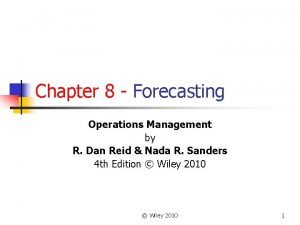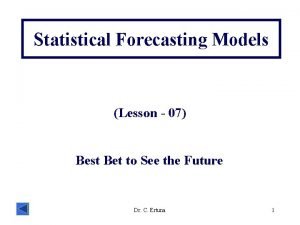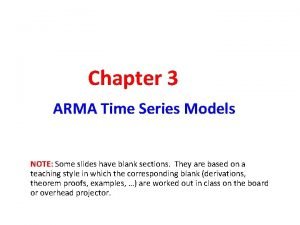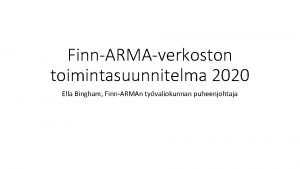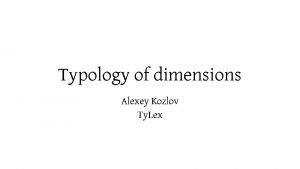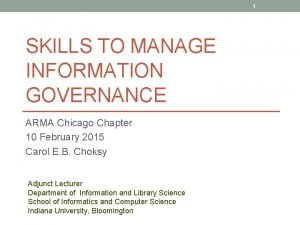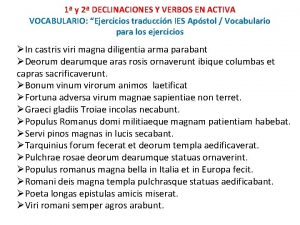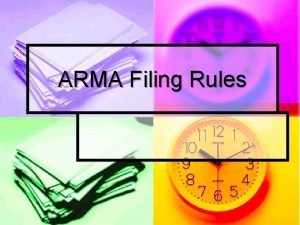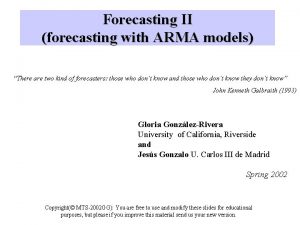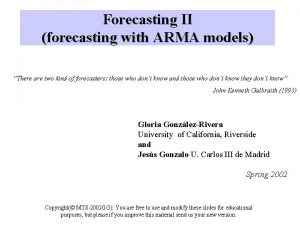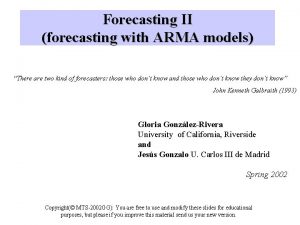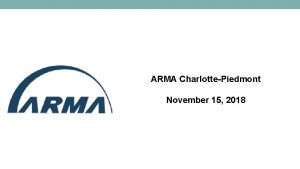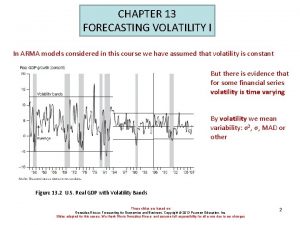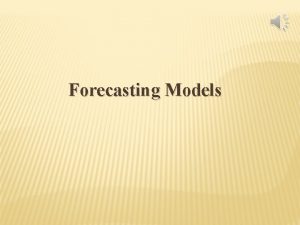Forecasting II forecasting with ARMA models There are



















- Slides: 19

Forecasting II (forecasting with ARMA models) “There are two kind of forecasters: those who don´t know and those who don´t know they don´t know” John Kenneth Galbraith (1993) Gloria González-Rivera University of California, Riverside and Jesús Gonzalo U. Carlos III de Madrid Copyright(© MTS-2002 GG): You are free to use and modify these slides for educational purposes, but please if you improve this material send us your new version.

Optimal forecast for ARMA models For a general ARMA process Objective: given information up to time n, want to forecast ‘l-step ahead’

Criterium: Minimize the mean square forecast error

Another interpretation of optimal forecast Consider Given a quadratic loss function, the optimal forecast is a conditional expectation, where the conditioning set is past information

Sources of forecast error When the forecast is using :

Properties of the forecast error MA(l-1) 1. The forecast and the forecast error are uncorrelated Unbiased

Properties of the forecast error (cont) 1 -step ahead forecast errors, , are uncorrelated In general, l-step ahead forecast errors (l>1) are correlated n-j n n-j+l n+l

Forecast of an AR(1) process The forecast decays geometrically as l increases

Forecast of an AR(p) process You need to calculate the previous forecasts l-1, l-2, ….

Forecast of a MA(1) That is the mean of the process

Forecast of a MA(q)

Forecast of an ARMA(1, 1)

Forecast of an ARMA(p, q) where

Example: ARMA(2, 2)

Updating forecasts Suppose you have information up to time n, such that When new information comes, can we update the previous forecasts?

Problems P 1: For each of the following models: (a) Find the l-step ahead forecast of Zn+l (b) Find the variance of the l-step ahead forecast error for l=1, 2, and 3. (c) P 2: Consider the IMA(1, 1) model (d) Write down the forecast equation that generates the forecasts (e) Find the 95% forecast limits produced by this model (f) Express the forecast as a weighted average of previous observations

Problems (cont) P 3: With the help of the annihilation operator (defined in the appendix) write down an expression for the forecast of an AR(1) model, in terms of Z. P 4: Do P 3 for an MA(1) model.

Appendix I: The Annihilation operator We are looking for a compact lag operator expression to be used to express the forecasts The annihilation operator is Then if

Appendix II: Forecasting based on lagged Z´s Let Then Wiener-Kolmogorov Prediction Formula
 Insidan region jh
Insidan region jh Types of forecasting models
Types of forecasting models Statistical forecasting models
Statistical forecasting models Semi modals examples
Semi modals examples Arma(2,1) model
Arma(2,1) model Finn arma
Finn arma Arma 3 whiteboard dimensions
Arma 3 whiteboard dimensions Arma tu ofrenda
Arma tu ofrenda Arma dacum
Arma dacum Como se arma
Como se arma Esametro eneide
Esametro eneide Armas atipicas
Armas atipicas Resmi belgelerdeki mühür arma
Resmi belgelerdeki mühür arma Arma nucleara definitie
Arma nucleara definitie In castris viri magna diligentia arma parabant
In castris viri magna diligentia arma parabant Arma indexing rules
Arma indexing rules Arma conference 2017
Arma conference 2017 Arma 3 toolkit
Arma 3 toolkit Finn-arma
Finn-arma Arma del reciario
Arma del reciario

